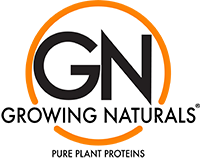
LAST UPDATED January 2025
To: Our Valued Customers
From: Growing Naturals' Quality Team
Since 2011, Growing Naturals has prioritized reducing heavy metal levels in our rice and pea protein powders as a core initiative. While achieving 100% metal-free food is impossible, we remain dedicated to progressively lowering naturally occurring heavy metals in our products year after year. Our objective is to surpass external trends in reducing these levels by leveraging advancements in research and technology, all while preserving the natural integrity of our products. As a proud producer of organic brown rice protein, we are committed to providing you with safe and reliable rice protein supplements that are lab-tested for metals by accredited third-party labs.
Why are there heavy metals in rice and pea protein powders? Many people mistakenly believe that metals are intentionally added to plant protein powders. In reality, metals are naturally present in all soils—organic and conventional—and are absorbed by plants (i.e. fruits, vegetables, nuts, grains, beans, etc.) in the same way they take in essential nutrients such as calcium, iron, and magnesium.
A comprehensive review titled "Heavy Metals in Foods and Beverages: Global Situation, Health Implications, and Regulations" discusses the natural occurrence of heavy metals in various foods, including fruits and vegetables, dairy products, seafood, meat, etc. The study highlights that both leafy and non-leafy vegetables can accumulate heavy metals from the soil, underscoring the ubiquitous presence of these elements in all plant-based foods. Thus when plant foods are processed into protein powder, some of the heavy metals remain in it. For further information, please see our article on "How did heavy metals get into my food/supplement?"
Does the presence of metals mean a product a unsafe to consume? The mere existence of heavy metals within a food product does not inherently dictate that it is unsafe for consumption, especially as many of the healthiest plant foods like spinach, carrots and avocado contain said metals. Instead, the safety of a food is primarily determined by the concentration or dosage of the metal present. For instance, while iron is typically regarded as a safe nutrient essential for human health, it can become hazardous and toxic when consumed in excessive amounts. This distinction underscores the importance of evaluating not just the presence of heavy metals, but also their specific levels within food products. A careful assessment of dosage is crucial, as even elements that are generally considered beneficial can pose significant health risks when ingested in high concentrations. We believe it is essential to monitor and regulate the levels of heavy metals in our products to ensure consumer safety effectively.
What are the levels of heavy metals in Growing Naturals rice and pea protein powders? To guarantee consumer safety, our routine quality testing includes heavy metal analysis for all products. We do not permit the release of any product that contains elevated levels of heavy metals. Each batch undergoes thorough testing, and our results consistently show very low levels. Currently, our products comply with the following heavy metal limits:
- Cadmium - below 0.30 ppm (parts per million)
- Lead - below 0.25 ppm
- Arsenic - below 0.20 ppm
- Mercury - below 0.045 ppm
It is important to highlight that our established criteria are more stringent than the FDA standards for food, which allow lead up to 10 ppm, arsenic up to 3 ppm, and mercury up to 1 ppm.
Although exact amounts vary from batch to batch, each metal will be below the above referenced levels. If you would like to know the exact level in your product, please email us info@growingnaturals.com and note the specific lot# printed on the bottom of your canister.
Why is Prop 65 on your rice and pea protein powder canisters? Prop 65 refers to a law enacted by the State of California for California residents only. The proposition was intended to protect California residents and the state’s drinking water sources from chemicals (including lead) known to cause cancer, birth defects, or other reproductive harm, and to inform citizens about exposures to such compounds via label warnings, no matter how infinitesimal or trace the exposure.
Because water is essential to life and may be consumed in copious amounts, the limit for chemical exposure in Prop65 was set extremely low. So low that amounts found naturally in healthy produce like spinach, avocado, nuts, etc. would be considerably higher than the established limit. And while such produce would warrant a Prop65 warning, they are exempt because of their status as whole fresh food.
Prop65 has since expanded to apply to any products sold in the state of California and warning signs are even commonly seen at every Starbucks.
While we, Growing Naturals, stand by the safety of our products, we had to place the labels on our rice protein canisters to abide by California law. In fact, we are so sure of its safety that all of our team members (and family members) consume this on a near daily basis.
How are you keeping metal levels down? We have worked closely with our supplier to influence the need for and identify geological areas that inherently have less naturally occurring heavy metals (vs. areas with higher levels due to historic volcanic activity, pollution etc.) for growing organic certified rice such as Cambodia and Vietnam. We have continuously tested products from raw material to protein powder at accredited laboratories, utilizing the newest and most reliable standards, to ensure accuracy and thus quality. Additionally, we have worked with a team of scientists to develop new procedures and technologies to limit the level of heavy metal at every stage, while still maintaining the natural status of the final protein powder.
Why don’t you source rice from the US? Unfortunately, the US does not produce enough Organic rice for us to use. According to the USDA, the US produces less than 2% of the world’s rice supply and about half of what it does produce is exported to other countries like Mexico and Japan (4). Out of the other half, only 6% is organically produced and about two-thirds are sold for consumption in its whole grain form (5). The remaining third is divvied up for processed foods, pet food and beer.
Consumer Education: We believe consumers can make better decisions for their well-being by having a well-rounded education about the positives and negatives of heavy metals and plant proteins. In conjunction with our ingredient supplier, Growing Naturals is embarking on a consumer education program to help buyers make informed decisions. Our goal is to educate consumers about more beneficial plant-based alternatives to the dairy products tens of millions of people cannot utilize due to intolerances, allergies or health benefits.
Programs included: • Press releases distributed to general and niched media contacts. • A national consumer media tour and online education program, featuring Dr. Janet (www.drjanet.com) and other experts. • General educational articles and research available for sharing, which can be found on www.GrowingNaturals.com. Visitors can go directly to www.GNstudies.com for study-based information and www.GNscoop.com for contributions from experts, including Growing Naturals’ in-house Registered Dietitian.
References:
- 2013. International Conference on Harmonisation of Technical Requirements for Registration of Pharmaceuticals for Human Use. Draft Consensus Guideline. Guideline for Elemental Impurities. Q3D. July 26, 2013.
- 2005. Toxicological Profile for Tungsten. Center for Disease Control and Prevention. Atlanta.
- Schroeder, H.A. and M. Mitchener. 1975. Life-term studies in rats: Effects of aluminum, barium, beryllium, and tungsten. Journal of Nutrition 105: 421-427
- Boriss, H. Rice profile. Agricultural Marketing Resource Center, US Department of Agriculture. July 2013. Available at: http://www.agmrc.org/commodities__products/grains__oilseeds/rice-profile/
- US rice domestic usage report: Milling Year 2011-2012. USA Rice Federation. Available at: http://www.usarice.com/doclib/188/231/6779.pdf
